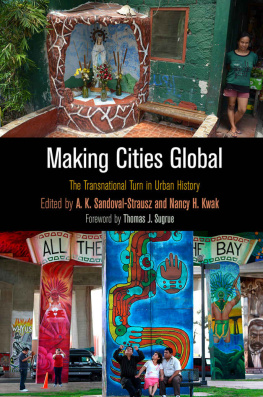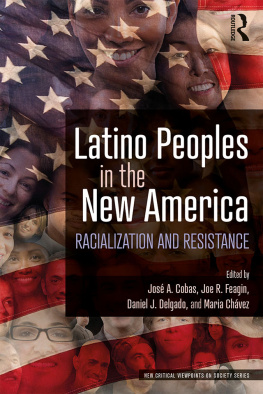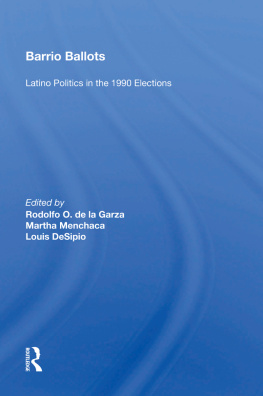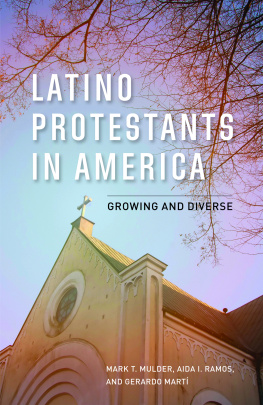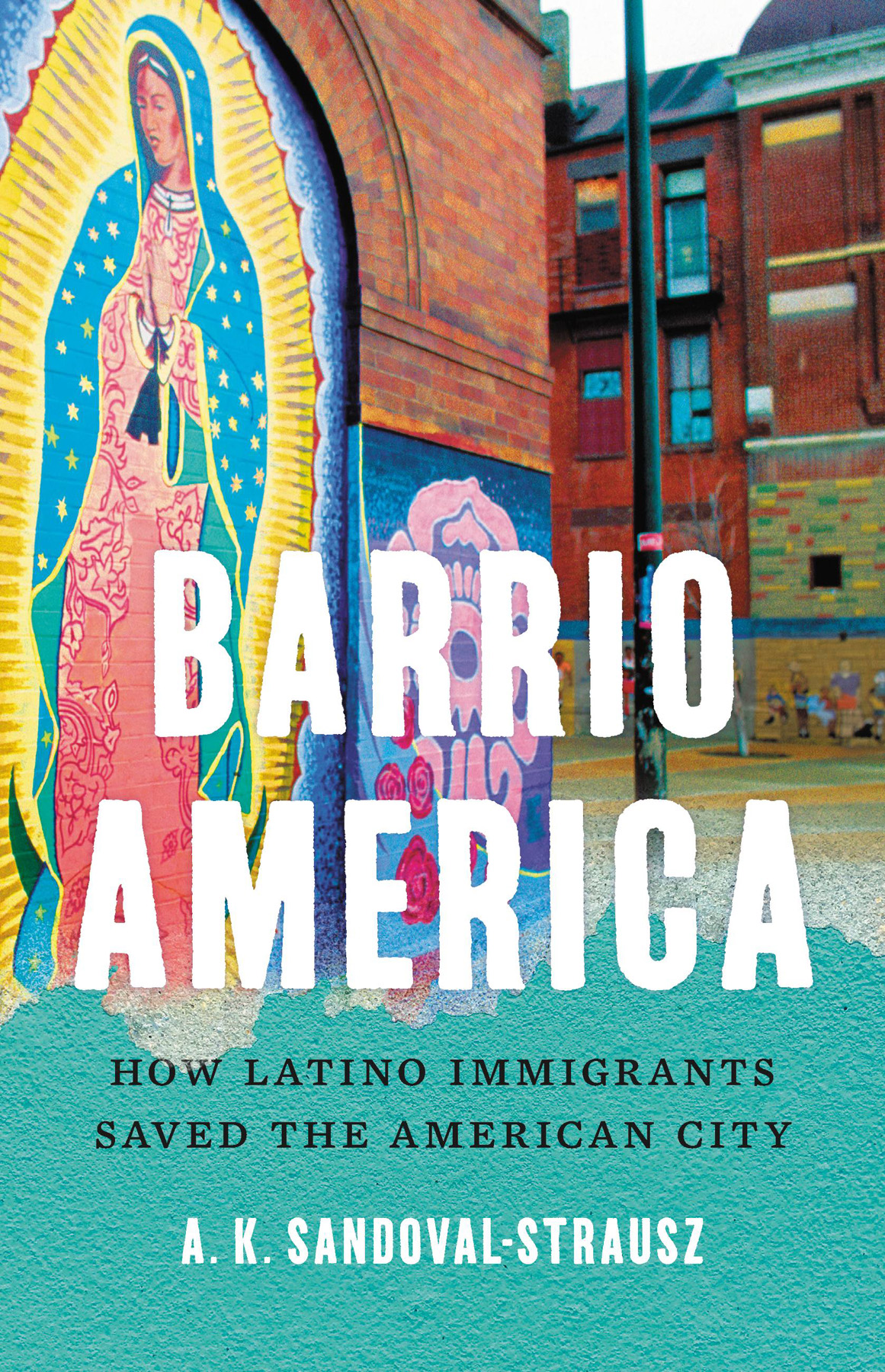Copyright 2019 by A. K. Sandoval-Strausz
Cover design by Ann Kirchner
Cover images Kelly/Mooney Photography/Getty Images; Daarsan/Shutterstock.com
Cover copyright 2019 Hachette Book Group, Inc.
Parts of this book appeared in different form as Latino Vernaculars and the Emerging National Landscape, Buildings & Landscapes: The Journal of the Vernacular Architecture Forum 20 (2013), 118; Latino Landscapes: Postwar Cities and the Transnational Origins of a New Urban America, Journal of American History 101 (2014), 804831; Migrantes, Negocios, and Infraestructura: Transnational Urban Revitalization in Chicago, in Immigration and Metropolitan Revitalization, eds. Domenic Vitiello and Thomas J. Sugrue (Philadelphia: University of Pennsylvania Press, 2017). Permission to use this material is gratefully acknowledged.
Carnaval del Barrio (from In the Heights), Finale (from In the Heights). Words and music by Lin-Manuel Miranda 2008. 5000 Broadway Music. All rights administered by WB Music Corp. All rights reserved. Used by permission.
Hachette Book Group supports the right to free expression and the value of copyright. The purpose of copyright is to encourage writers and artists to produce the creative works that enrich our culture.
The scanning, uploading, and distribution of this book without permission is a theft of the authors intellectual property. If you would like permission to use material from the book (other than for review purposes), please contact permissions@hbgusa.com. Thank you for your support of the authors rights.
Basic Books
Hachette Book Group
1290 Avenue of the Americas, New York, NY 10104
www.basicbooks.com
First Edition: November 2019
Published by Basic Books, an imprint of Perseus Books, LLC, a subsidiary of Hachette Book Group, Inc. The Basic Books name and logo is a trademark of the Hachette Book Group.
The Hachette Speakers Bureau provides a wide range of authors for speaking events. To find out more, go to www.hachettespeakersbureau.com or call (866) 376-6591.
The publisher is not responsible for websites (or their content) that are not owned by the publisher.
Library of Congress Cataloging-in-Publication Data
Names: Sandoval-Strausz, A. K., author.
Title: Barrio America: How Latino Immigrants Saved the American City / A. K. Sandoval-Strausz.
Description: First edition. | New York: Basic Books, Hachette Book Group, 2019. | Includes bibliographical references and index.
Identifiers: LCCN 2019014405 (print) | LCCN 2019980679 (ebook) | ISBN 9781541697249 (hardcover) | ISBN 9781541644434 (ebook)
Subjects: LCSH: Urban renewalUnited StatesCase studies. | NeighborhoodsUnited StatesCase studies. | Cities and townsStudy and teachingUnited StatesCase studies. | Community development, UrbanUnited StatesCase studies. | Hispanic AmericansCase studies.
Classification: LCC HT175 .S25 2019 (print) | LCC HT175 (ebook) | DDC 307.3/4160973dc23
LC record available at https://lccn.loc.gov/2019014405
LC ebook record available at https://lccn.loc.gov/2019980679
ISBNs: 978-1-5416-9724-9 (hardcover), 978-1-5416-4443-4 (e-book)
E3-20191004-JV-NF-ORI
Barrio America is the strongest, most sophisticated rebuttal to the notion that immigration from Latin America threatens our country. In prose as eloquent as it is prescient, A. K. Sandoval-Strausz upends the notion that Americas cities were in decay from the 1960s to the current moment of revitalization. He shows how Latinx migrants initiated this recovery and have sustained it in the face of xenophobia, public divestment, and neglect. Finally, someone has honored the sacrifices of the most maligned immigrant community of our time.
Matthew J. Garcia, author of From the Jaws of Victory: The Triumph and Tragedy of Cesar Chavez and the Farm Worker Movement
By illuminating national trends in urban policy and bringing Latin American migrants to life through their personal oral histories, A. K. Sandoval-Strausz underscores why you cant understand American cities without studying Latinos. In Barrio America, he expertly explains how Latinos renewed our urban spaces through homeownership, contributed to cities cultural vibrancy, and how, through their actions and presence, they opened the doors for our current urban revival.
Rosina Lozano, Princeton University, author of An American Language: The History of Spanish in the United States
Barrio America shows that immigration is rejuvenation. In this compelling, persuasive history, Sandoval-Strausz shows how Latino and Latina immigrants acted as a grassroots-level force of urban revitalization. With a message urgent for our times, it reminds us that immigrants have for centuries infused our cities with life and promise, and that Hispanics are a vital part of this long American tradition.
Becky Nicolaides, research affiliate, UCLA Center for the Study of Women and Huntington-USC Institute on California and the West
Hotel: An American History
Making Cities Global: The Transnational Turn in Urban History (coedited with Nancy H. Kwak)
To mi madre y mi padre,
Cecilia and Ivan,
who were children in worlds on fire
before finding a home here;
to mi vida,
Cathleen,
who is extraordinary in too many ways to count
and whose very presence makes everything more fun;
and to mis hijos,
Cecilia and Lincoln,
the most beautiful children imaginable
for whose generation we need to save this world.
The foreigner residing among you must be treated as your native-born. Love them as yourself, for you were foreigners in Egypt. I am the Lord your God.
LEVITICUS 19:34
O N A QUIET STREET IN DALLASS OAK CLIFF NEIGHBORHOOD , in a second-story addition that rises behind a modest yellow wood-frame house, sits the headquarters of the Federation of Zacatecan Clubs of North Texas. From the outside, the clubhouse is so unassuming that you could pass right by for years without ever knowing it was there. Upon stepping through the door, the first thing a visitor notices is the ten-foot-wide, floor-to-ceiling display on the east wall of the clubhouse. A pair of formal brass poles are mounted diagonally on the wall, each bearing a large flag: one of the United States, the other of Mexico. The banners are spread wide and carefully draped to create elegant folds in the bright fabric. In a dark wood frame between the flags hangs the official seal of the Mexican state of Zacatecas. The image, drawn from the original coat of arms bestowed by Philip II of Spain in 1588, features La Virgen del Patrocinio, the Child in her arms, flanked by the sun and moon; beneath her, four armored conquistadors look up in wonder.


